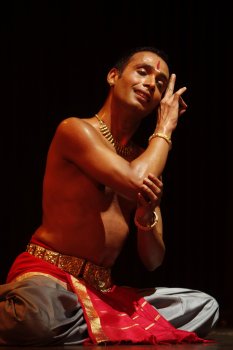
|   |

|   |
Wholesome recital - Jyothi Raghuram, Bangalore e-mail: jyothi.r.ram@gmail.com April 23, 2012 If one has been watching a dancer on stage for several years, one can't but help assess him against his experience, rather than take a single recital into consideration per se. Going by this criterion, one should say that Bharatanatyam dancer Seshadri Iyengar has honed his skills very well to metamorphose into a male dancer who can hold a full-length solo recital on his own, and without having to take recourse to presenting numbers that are more suitable to his gender. And this is saying a lot because one has to concede that Bharatanatyam is essentially a feminine art where male dancers thus face a certain disadvantage.  Seshadri's recital at MES College, Bangalore, on April 22, for Kalavedi, the active cultural wing of the MES institutions, was crisp, demonstrating exactitude in nritta, clearly imprinted hastas and their placements, creative and varied dance compositions, and a well thought-out balanced margam, with a high musical quotient. "Innum yen manam", the Charukesi varnam which one has seen being portrayed by Seshadri's guru Padmini Ravi so many times, brought out the virhothkhantitha nayika quite clearly, while the Yamankalyani kriti "Kadagola taarenna" and the Tilang bhajan "Jaya Sri Vaikunta Mukunda" were lively in themselves, with Seshadri emoting adequately. Parental love, however, was not discernible in the popular Bharatiyar poem "Chinnanjeera Kiliye" (Ragamalika). The amazing stamina displayed by the dancer without let-up till the end, revealed rigorous and sustained practice. The hard work put into moulding himself into more than a mere performer was also visible in his dance compositions - the brief and buoyant Pushpanjali, where some fresh thinking had gone into the movements, the Yamankalyani kriti, and the korvais tailored to suit him, as well as the contextual sancharis in the varnam, with the overall inputs of his teacher. The recital provided food for thought inadvertently too - K J Sarasa, Padma Subrahmanyam, Padmini Ravi and Seshadri himself were the dance composers for the items, which meant they came from different "styles" or schools of dance. Although Padmini traces her roots to Sarasa, and the lineage continues through Seshadri, it not only marks three generations but points out that they come with their own creative ideas. So where is the distinction in styles, if viewed in the totality of dance, for there was nothing incongruous in the knitting together of the numbers. That it was a good show of variety, agility vis a vis footwork, overall tidiness and watchable, was all that counted. Do we need to harangue about styles as such, is the moot question. Seshadri's well- trained abhinaya, though not bereft of feeling, was no match to his sprightly nritta. Keeping a check on his smiling countenance, and refraining from bringing in unnecessary expressions while executing nritta, would help. While his taut torso is an enviable enhancer of his stance, some flexions would add to his grace - as gleaned in the Kadanakuthuhala Tillana. His extremely close-cropped hairstyle did nothing for his otherwise youthful appearance, aided in no small measure by a trim and fit physique. Coming to the accompanists, maybe it sounds premature to say that "a star is re-born", while talking of the chollukattus enunciated by Lakshmi Ravi. It had the force and robustness of youth, and her hold over rhythm was admirable. It was a rare feat to be savored for long, especially viewed against the dance scene of the region. Seeing the very talented Lakshmi's rare presence in the wings brought back memories when she had conducted the nattuvangam for her mother Padmini even before she had entered her teens. It was as welcoming to see Guru Padmini Ravi wielding the cymbals with her usual panache. Neela Ramanujam (vocal) led the musical support with her excellent range, aided by Giridhar (mridangam), and Karthik (flute). A word of appreciation is absolutely necessary for Kalavedi under the stewardship of its Secretary Vimala Rangachar, which has brought some of the best of traditional performing arts to this side of the city, reviving its cultural moorings. Jyothi Raghuram is a journalist with over two decades experience in both the print and electronic media, having worked with news organizations such as PTI, The Hindu and Indian Express. Her specialized writings on the performing and visual arts have been considered as benchmarks for their comprehensive and in-depth dealing of the subjects. |